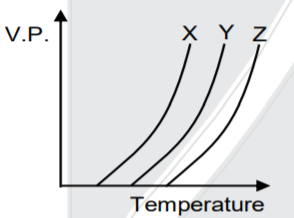Which state of matter has least intermolecular forces of attraction?
To determine which state of matter has the least intermolecular forces of attraction, we can analyze the characteristics of solids, liquids, and gases.
1. Identify the States of Matter:
- Matter exists in three primary states: solid, liquid, and gas.
2. Examine Solids:
- Solids have a definite shape and volume.
- The particles in solids are closely packed together and vibrate in fixed positions due to strong intermolecular forces of attraction.
- This rigidity indicates that solids have the strongest intermolecular forces among the three states.
3. Examine Liquids:
- Liquids have a definite volume but take the shape of their container.
- The particles in liquids are less tightly packed than in solids, allowing them to move more freely.
- This indicates that the intermolecular forces in liquids are weaker than those in solids, but stronger than those in gases.
4. Examine Gases:
- Gases have neither a definite shape nor a definite volume.
- The particles in gases are far apart and move randomly at high speeds.
- The intermolecular forces of attraction in gases are minimal, allowing the particles to move freely without significant interaction.
5. Conclusion:
- Comparing the three states, gases have the least intermolecular forces of attraction.
- Therefore, the state of matter with the least intermolecular forces of attraction is gas.
Final Answer:
The gaseous state of matter has the least intermolecular forces of attraction.
---
- Matter exists in three primary states: solid, liquid, and gas.
- Solids have a definite shape and volume.
- The particles in solids are closely packed together and vibrate in fixed positions due to strong intermolecular forces of attraction.
- This rigidity indicates that solids have the strongest intermolecular forces among the three states.
- Liquids have a definite volume but take the shape of their container.
- The particles in liquids are less tightly packed than in solids, allowing them to move more freely.
- This indicates that the intermolecular forces in liquids are weaker than those in solids, but stronger than those in gases.
- Gases have neither a definite shape nor a definite volume.
- The particles in gases are far apart and move randomly at high speeds.
- The intermolecular forces of attraction in gases are minimal, allowing the particles to move freely without significant interaction.
- Comparing the three states, gases have the least intermolecular forces of attraction.
- Therefore, the state of matter with the least intermolecular forces of attraction is gas.
The gaseous state of matter has the least intermolecular forces of attraction.
Topper's Solved these Questions
- STATES OF MATTERBOOK - AAKASH INSTITUTE ENGLISHCHAPTER - STATES OF MATTEREXERCISE - EXERCISE
40 Videos
- STATES OF MATTERBOOK - AAKASH INSTITUTE ENGLISHCHAPTER - STATES OF MATTEREXERCISE - TRY YOURSELF
34 Videos
- SOME BASIC CONCEPTS OF CHEMISTRY BOOK - AAKASH INSTITUTE ENGLISHCHAPTER - SOME BASIC CONCEPTS OF CHEMISTRY EXERCISE - ASSIGNMENT SECTION J (Aakash Challenges Questions)
10 Videos
- STRUCTURE OF ATOMBOOK - AAKASH INSTITUTE ENGLISHCHAPTER - STRUCTURE OF ATOMEXERCISE - ASSIGNMENT (SECTION -D) Assertion-Reason Type Questions
15 Videos
Similar Questions
Which characterises the weak intermolecular forces of attraction in a liquid?
View SolutionState of matter having strongest inter-particle forces of attraction.
View SolutionState whether this is true or false? The intermolecular force of attraction is the strongest in gases.
View SolutionIn which of the following mixtures, the London dispersion force acts as major intermolecular force of attraction ?
View SolutionAssertion : The pressure of real gas is less than the pressure of ideal gas. Reason : Intermolecular forces of attraction in real gases are greater than in ideal gas.
View SolutionAssertion : The pressure of real gas is less than the pressure of ideal gas. Reason : Intermolecular forces of attraction in real gases are greater than in ideal gas.
View SolutionState whether it is True or False: The intermolecular force of attraction in liquids is as strong as that in solids.
View Solution '
'
A. Intermolecular force of attraction of X gt Y
B. Intermolecular force of attraction of X lt Y
C. Intermolecular force of attraction of Z lt X.
Select the correct option(s).
View Solution '
'
A. Intermolecular force of attraction of X gt Y
B. Intermolecular force of attraction of X lt Y
C. Intermolecular force of attraction of Z lt X.
Select the correct option(s).
View SolutionStatement 1:Bakelite is hard and has high melting point
Statement 2:Intermolecular forces of attractions in it are H-bonding.
View Solution
